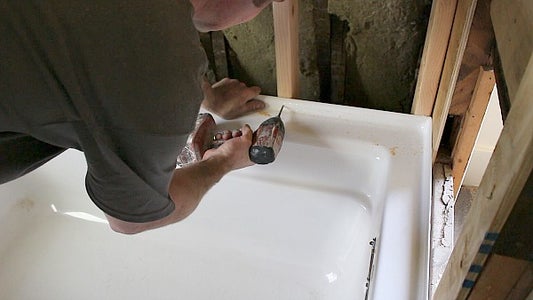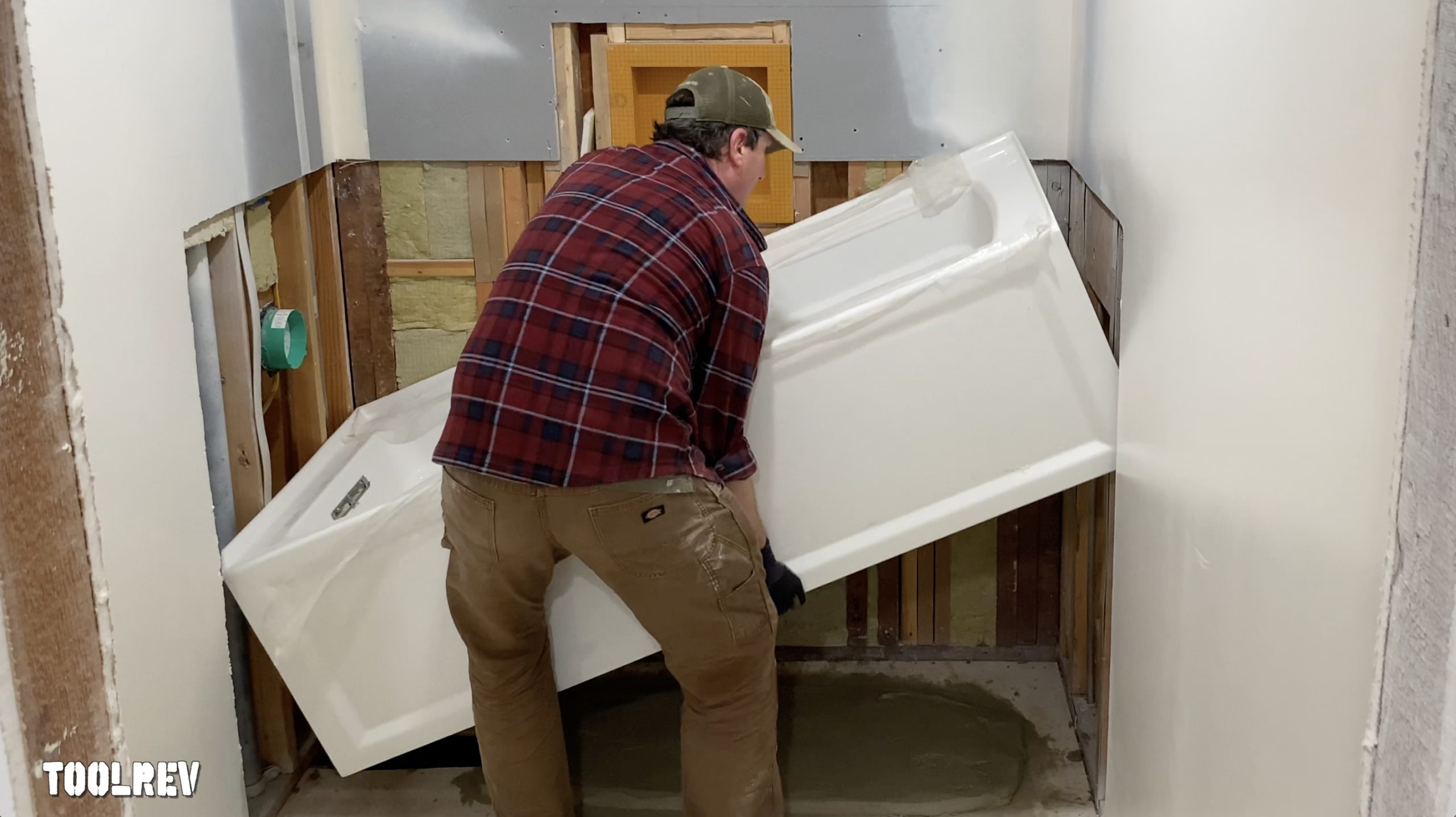On this page down the page you will discover a bunch of quality expertise with regards to Tools You Need to Install a New Bathtub .

Installing a tub isn't precisely brain surgery, but it does need solid plumbing, woodworking, and in some cases, tiling abilities. Changing an old bath tub with a new one is likewise a moderately challenging job. If the old bathtub is conveniently accessible, the project can move immediately; if you have to open up a wall surface to remove the old tub as well as place the brand-new bath tub, the job is a lot harder. In either case, the project is within a home handyman's skills, although you will require an assistant to vacate the old bathtub and also embeded in the brand-new one. Make sure you have actually qualified yourself for the job and are comfortable attempting it. Instead of working with a service provider to take control of a halfway-completed task, it is far better to take into consideration using one prior to you start. Possibilities are you might require an expert plumber to make tube links.
This article will help you install a new bathtub in your bathroom if you have actually currently acquired a brand-new bathtub and also do not need to alter the plan of your previous water supply pipes.
Your devices and also product list should comprise the following:
- New Bathtub
- Hammer
- Pipeline Wrenches
- Prybar
- Shatterproof glass
- Degree
- Pliers
- Flexible Wrench
- Putty Knife
- Screwdriver
- Cold Blade
- Tape Measure
- Pipeline Caps
Removing Old Taps
If you need to replace old faucets with brand-new ones as a part of your setup, then the first thing you ought to do is disconnect the water supply. After doing so, activate the faucets to drain any water remaining in the system. The procedure of eliminating the existing taps can be quite bothersome because of the limited gain access to that is commonly the situation.
Use a container wrench (crowsfoot spanner) or a faucet tool to undo the nut that attaches the supply pipelines to the taps. Have a towel prepared for the staying water that will originate from the pipes. Once the supply pipelines have been gotten rid of, utilize the same device to loosen the nut that holds the faucets onto the bath/basin. You will certainly require to stop the solitary taps from turning throughout this process. As soon as the faucets have been gotten rid of, the holes in the bath/basin will need to be cleansed of any type of old securing substance.
Before carrying on to fit the new faucets, compare the pipeline connections on the old faucets to the new faucets. If the old taps are longer than the brand-new taps, after that a shank adapter is required for the brand-new taps to fit.
Suitable New Taps
If the tails of the brand-new taps are plastic, after that you will require a plastic connector to stop damage to the string. One end of the connector fits on the plastic tail of the faucet and the various other end provides a link to the existent supply pipelines.
If you need to fit a monobloc, then you will certainly need lowering couplers, which connects the 10mm pipeline of the monobloc to the basic 15mm supply pipeline.
Next, position the faucet in the mounting opening in the bath/basin ensuring that the washers remain in place in between the faucet and the sink. Protect the tap in place with the supplier provided backnut. Once the faucet is safely in position, the supply pipes can be connected to the tails of the faucets. The faucets can either be connected by utilizing corrugated copper piping or with regular tap ports. The previous type ought to be linked to the tap ends first, tightening up just by hand. The supply pipes can later be attached to the various other end. Tighten both ends with a spanner after both ends have been attached.
Installing the Bathtub
Utilizing both wood boards under its feet, place the tub in the needed setting. The wood boards are handy in evenly spreading the weight of the tub over the location of the boards as opposed to focusing all the weight onto four little factors.
The following objective is to ensure that the bathtub is leveled all round. This can be accomplished by inspecting the level and also readjusting the feet on the bathtub until the spirit level reviews level.
To set up faucets, fit all-time low of the outermost adaptable tap connector to the appropriate supply pipe by making a compression join; then do the exact same for the various other faucet.
Turn on the water and also examine all joints and also new pipework for leakages and also tighten them if essential. Load the bath tub as well as additionally examine the overflow electrical outlet and also the regular electrical outlet for leakages.
Ultimately, deal with the bathroom paneling as defined in the maker's user's manual. Tiling as well as sealing around the tub ought to wait until the bathtub has been made use of at the very least when as this will certainly resolve it right into its final position.
Getting ready for the Installation
Firstly, the supporting structure provided with the bathroom ought to be fitted (if needed) according to the producer's instructions. Next off, fit the faucets or mixer to the tub. When fitting the tap block, it is important to make sure that if the faucet includes a plastic washer, it is fitted between the bathroom and also the faucets. On a plastic bath, it is also reasonable to fit a sustaining plate under the taps unit to stop stress on the tub.
Fit the flexible faucet ports to the bottom of the two faucets utilizing 2 nuts and olives (occasionally provided with the tub). Fit the plug-hole electrical outlet by smearing mastic filler round the sink electrical outlet hole, and then pass the electrical outlet with the hole in the bath. Make use of the nut supplied by the manufacturer to fit the plug-hole. Check out the plug-hole outlet for an inlet on the side for the overflow pipeline.
Next off, fit the end of the adaptable overflow pipe to the overflow outlet. Afterwards, screw the pipe to the overflow face which need to be fitted inside the bath. Make sure you make use of all of the provided washers.
Connect the catch to the bottom of the waste outlet on the bath tub by winding the thread of the waste electrical outlet with silicone mastic or PTFE tape, as well as screw on the catch to the electrical outlet. Connect all-time low of the overflow tube in a similar manner.The bathroom should currently be ready to be suited its final placement.
Tiling Around the Bathtub
In the location where the bath fulfills the tile, it is essential to seal the accompanies a silicone rubber caulking. This is essential as the installation can relocate enough to fracture a rigid seal, creating the water to penetrate the wall surface between the bath and also the tiling, resulting in difficulties with dampness and also possible leaks to the ceiling below.
You can pick from a variety of coloured sealers to assimilate your fixtures and also fittings. They are marketed in tubes and cartridges, as well as can sealing spaces approximately a size of 3mm (1/8 inch). If you have a larger space to load, you can fill it with twists of drenched paper or soft rope. Remember to constantly load the bathtub with water before securing, to permit the movement experienced when the bathtub remains in use. The sealant can split rather early if you do not take into consideration this activity prior to sealing.
Additionally, ceramic coving or quadrant floor tiles can be made use of to edge the bathroom or shower tray. Plastic strips of coving, which are easy to use and cut to size, are additionally conveniently available on the market. It is a good idea to fit the floor tiles making use of water-resistant or water resistant sticky and also grout.
Bathtub Installation
How Important Is A Bathtub To Your Home?
High-quality baths, showers, and other bathroom updates are necessary when considering a smart investment in your home. It’s a room that you go to every day and one that is constantly being used by guests.The bathroom is one of the top trafficked rooms in a home and also one of the most valuable in terms of home resale.
Install Piping Before Tub
You will be using your existing drain and waste vent system, but pipes required include the hot and cold water supply lines and a pipe leading to a shower head. A mixing valve and shower head are also needed. Air chambers may be required.
Position the Tub
Lower the tub into place so that the continuous flange fits against the wall studs and rests on 1’x4' or 2’x4' supports. Anchor the tub to the enclosure with nails or screws inserted through the flanges into the studs.
NOTE: Remember, bathtubs and shower stalls may require support framing. A bathtub filled with water is extremely heavy, so check building codes and framing support before installing the tub.
Assemble Drain Connections
Assemble the bathtub drain connections by connecting the tub overflow with the tub drain above the trap, not beyond it. The trap will have a compression fitting that screws over the arm of the overflow assembly.
Place a Pipe For the Shower Head
First, locate a brass female threaded winged fitting and attach it to a framing support via a screw or a nail. Then run a pipe up the wall for the shower head. Sweat or solder the other side of the brass fitting to the top of the pipe.
Attaching Hot and Cold Water Lines
Attach your water lines for both hot and cold by sweating these directly into the hot and cold ports of the mixing valve. The mixing valve will be how water enters the tub’s system, not by the pipes themselves.
Install the Spout
Extend a piece of 1/2 inch pipe, or whichever length is specified in the manufacturer’s instructions, for the tub spout. Sweat on a male threaded fitting at the end of the pipe or use a brass nipple of the proper length and a 1/2 inch cap.
NOTE: At this point you should have your rough-in plumbing work inspected before proceeding further.
Check For Leaks
Restore the water pressure and check the drain connection and the supply pipes for any sign of leaking.
estore the Bathroom Wall
Replace the wall with moisture-resistant drywall as a base for your wall covering. Seal the joints between the wall and your new tub with silicone caulk as protection against water seepage.
https://www.berkeys.com/2016/12/02/bathtub-installation-dallas/

Do you appreciate more info about How to Install a Bathtub Yourself? Try to leave feedback further down. We would be delighted to know your suggestions about this review. Hoping that you come back again before long. Kindly take the time to distribute this content if you appreciated it. Thanks for your time. Kindly stop by our blog back soon.
Book Today!
Comments on “Can I Install a Bathtub Myself? Factors to Consider As Well As Actions”